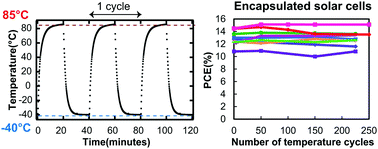当前位置:
X-MOL 学术
›
Energy Environ. Sci.
›
论文详情
Our official English website, www.x-mol.net, welcomes your feedback! (Note: you will need to create a separate account there.)
Design and understanding of encapsulated perovskite solar cells to withstand temperature cycling
Energy & Environmental Science ( IF 32.5 ) Pub Date : 2017-10-20 00:00:00 , DOI: 10.1039/c7ee02564e Rongrong Cheacharoen 1, 2, 3, 4, 5 , Nicholas Rolston 2, 3, 4, 5, 6 , Duncan Harwood 5, 7, 8 , Kevin A. Bush 1, 2, 3, 4, 5 , Reinhold H. Dauskardt 1, 2, 3, 4, 5 , Michael D. McGehee 1, 2, 3, 4, 5
Energy & Environmental Science ( IF 32.5 ) Pub Date : 2017-10-20 00:00:00 , DOI: 10.1039/c7ee02564e Rongrong Cheacharoen 1, 2, 3, 4, 5 , Nicholas Rolston 2, 3, 4, 5, 6 , Duncan Harwood 5, 7, 8 , Kevin A. Bush 1, 2, 3, 4, 5 , Reinhold H. Dauskardt 1, 2, 3, 4, 5 , Michael D. McGehee 1, 2, 3, 4, 5
Affiliation

|
The performance of perovskite solar cells has rapidly increased above 22%, and their environmental stability is also progressing. However, the mismatch in thermal expansion coefficients and low fracture energy of layers in perovskite solar cells raise a concern as to whether devices can withstand mechanical stresses from temperature fluctuations. We measured the fracture energy of a perovskite film stack, which was shown to produce 23.6% efficiency when incorporated in a monolithic perovskite-silicon tandem. We found that the fracture energy increased by a factor of two after 250 standardized temperature cycles between −40 °C and 85 °C and a factor of four after laminating an encapsulant on top of the stack. In order to observe how the increased mechanical stability translated from film stacks to device performance and reliability, we carried out a comparative study of perovskite solar cells packaged between glass and two commonly used encapsulants with different elastic moduli. We demonstrated that solar cells encapsulated with a stiffer ionomer, Surlyn, severely decreased in performance with temperature cycling and delaminated. However, the solar cells encapsulated in softer ethylene vinyl acetate withstood temperature cycling and retained over 90% of their initial performance after 200 temperature cycles. This work demonstrates a need for an encapsulant with a low elastic modulus to enable mechanical stability and progress toward 25 year operating lifetime.
中文翻译:

设计和理解封装钙钛矿太阳能电池以承受温度循环
钙钛矿太阳能电池的性能已迅速提高到22%以上,并且其环境稳定性也在不断提高。然而,钙钛矿太阳能电池中热膨胀系数的不匹配和层的低断裂能引起人们对器件是否能够承受温度波动引起的机械应力的担忧。我们测量了钙钛矿薄膜叠层的断裂能,将其整合到整体式钙钛矿-硅串联结构中可产生23.6%的效率。我们发现,在−40°C至85°C之间的250个标准化温度循环后,断裂能增加了两倍,而在堆栈顶部层压密封剂后,断裂能增加了四倍。为了观察增加的机械稳定性如何从薄膜叠层转化为器件的性能和可靠性,我们对包装在玻璃和两种具有不同弹性模量的常用密封剂之间的钙钛矿太阳能电池进行了比较研究。我们证明,封装有更硬的离聚物Surlyn的太阳能电池会随着温度循环而严重降低性能,并发生分层。然而,封装在较软的乙烯乙酸乙烯酯中的太阳能电池经受了温度循环,并且在200个温度循环后仍保持了其初始性能的90%以上。这项工作表明需要具有低弹性模量的密封剂,以实现机械稳定性并朝着25年的工作寿命发展。温度循环会严重降低性能并分层。然而,封装在较软的乙烯乙酸乙烯酯中的太阳能电池经受了温度循环,并且在200个温度循环后仍保持了其初始性能的90%以上。这项工作表明需要具有低弹性模量的密封剂,以实现机械稳定性并朝着25年的工作寿命发展。温度循环会严重降低性能并分层。然而,封装在较软的乙烯乙酸乙烯酯中的太阳能电池经受了温度循环,并且在200个温度循环后仍保持了其初始性能的90%以上。这项工作表明需要具有低弹性模量的密封剂,以实现机械稳定性并朝着25年的工作寿命发展。
更新日期:2017-10-30
中文翻译:

设计和理解封装钙钛矿太阳能电池以承受温度循环
钙钛矿太阳能电池的性能已迅速提高到22%以上,并且其环境稳定性也在不断提高。然而,钙钛矿太阳能电池中热膨胀系数的不匹配和层的低断裂能引起人们对器件是否能够承受温度波动引起的机械应力的担忧。我们测量了钙钛矿薄膜叠层的断裂能,将其整合到整体式钙钛矿-硅串联结构中可产生23.6%的效率。我们发现,在−40°C至85°C之间的250个标准化温度循环后,断裂能增加了两倍,而在堆栈顶部层压密封剂后,断裂能增加了四倍。为了观察增加的机械稳定性如何从薄膜叠层转化为器件的性能和可靠性,我们对包装在玻璃和两种具有不同弹性模量的常用密封剂之间的钙钛矿太阳能电池进行了比较研究。我们证明,封装有更硬的离聚物Surlyn的太阳能电池会随着温度循环而严重降低性能,并发生分层。然而,封装在较软的乙烯乙酸乙烯酯中的太阳能电池经受了温度循环,并且在200个温度循环后仍保持了其初始性能的90%以上。这项工作表明需要具有低弹性模量的密封剂,以实现机械稳定性并朝着25年的工作寿命发展。温度循环会严重降低性能并分层。然而,封装在较软的乙烯乙酸乙烯酯中的太阳能电池经受了温度循环,并且在200个温度循环后仍保持了其初始性能的90%以上。这项工作表明需要具有低弹性模量的密封剂,以实现机械稳定性并朝着25年的工作寿命发展。温度循环会严重降低性能并分层。然而,封装在较软的乙烯乙酸乙烯酯中的太阳能电池经受了温度循环,并且在200个温度循环后仍保持了其初始性能的90%以上。这项工作表明需要具有低弹性模量的密封剂,以实现机械稳定性并朝着25年的工作寿命发展。


























 京公网安备 11010802027423号
京公网安备 11010802027423号